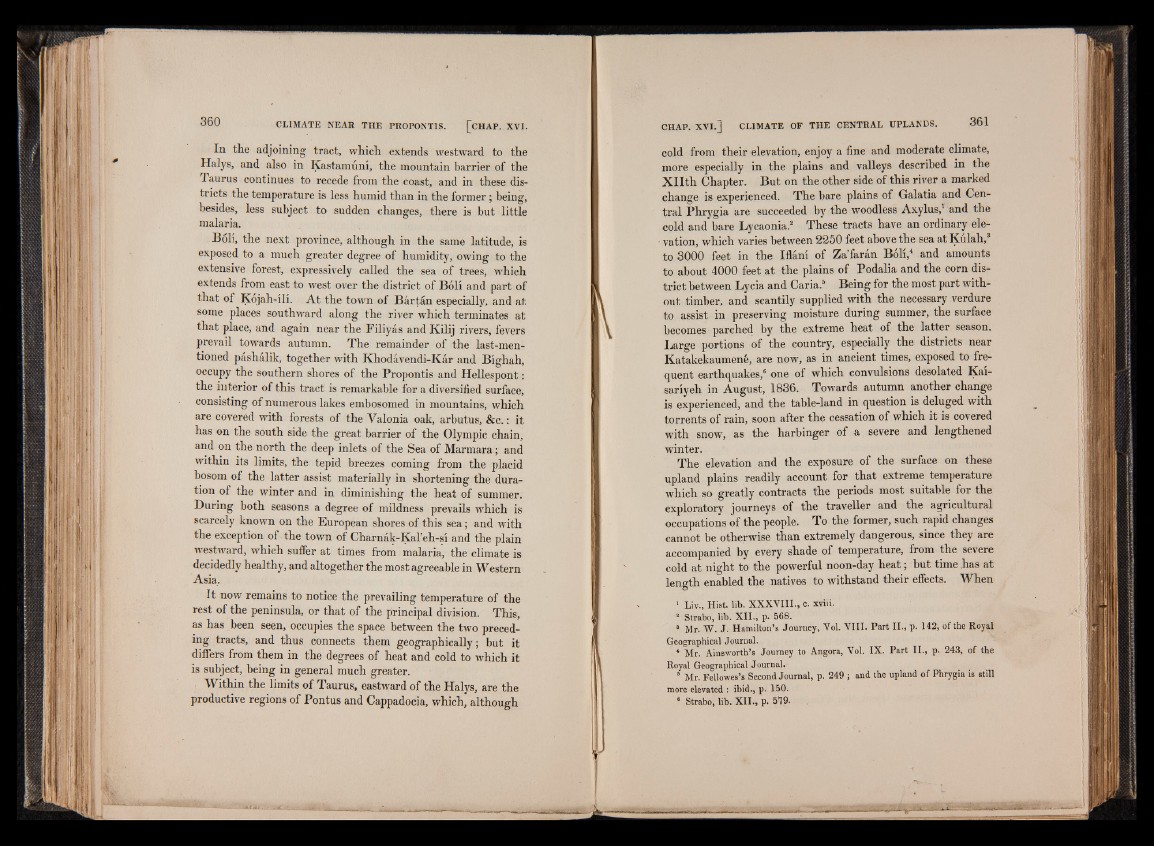
In the adjoining tract, which extends westward to the
Halys, and also in Kastamuni, the mountain barrier of the
Taurus continues to recede from the coast, and in these districts
the temperature is less humid than in the former; being,
besides, less subject to sudden changes, there is but little
malaria.
Boli, the next province, although in the same latitude, is
exposed to a much greater degree of humidity, owing to the
extensive forest, expressively called the sea of trees, which
extends from east to west over the district of Boli and part of
that of Kojah-ili. At the town of Bartan especially, and at
some places southward along the river which terminates at
that place, and again near the Filiyas and Kilij rivers, fevers
prevail towards autumn. The remainder of the last-mentioned
pashalik, together with Khodavendi-Kar and Bighah,
occupy the southern shores of the Propontis and Hellespont:
the interior of this tract is remarkable for a diversified surface,
consisting of numerous lakes embosomed in mountains, which
are covered with forests of the Valonia oak, arbutus, &c.: it
has on the south side the great barrier of the Olympic chain,
and on the north the deep inlets of the Sea of Marmara; and
within its limits, the tepid breezes coming from the placid
bosom of the latter assist materially in shortening the duration
of the winter and in diminishing the heat of summer.
During both seasons a degree of mildness prevails which is
scarcely known on the European shores of this sea; and with
the exception of the town of Charnak-Kal’eh-si and the plain
westward, which suffer at times from malaria, the climate is
decidedly healthy, and altogether the most agreeable in Western
Asia.
It now remains to notice the prevailing temperature of the
rest of the peninsula, or that of the principal division. This,
as has been seen, occupies the space between the two preced-
ing tracts, and thus connects them geographically; but it
differs from them in the degrees of heat and cold to which it
is subject, being in general much greater.
Within the limits of Taurus, eastward of the Halys, are the
productive regions of Pontus and Cappadocia, which, although
cold from their elevation, enjoy a fine and moderate climate,
more especially in the plains and valleys described in the
XHth Chapter. But on the other side of this river a marked
change is experienced. The bare plains of Galatia and Central
Phrygia are succeeded by the woodless Axylus,1 and the
cold and bare Lycaonia.2 These tracts have an ordinary elevation,
which varies between 2250 feet above the sea at Kulah,3
to 3000 feet in the Iflani of Za’faran Boli,4 and amounts
to about 4000 feet at the plains of Podalia and the corn district
between Lycia and Caria.5 Being for the most part without
timber, and scantily supplied with the necessary verdure
to assist in preserving moisture during summer, the surface
becomes parched by the extreme heat of the latter season.
Large portions of the country, especially the districts near
Katakekaumene, are now, as in ancient times, exposed to frequent
earthquakes,6 one of which convulsions desolated Kai-
sariyeh in August, 1836. Towards autumn another change
is experienced, and the table-land in question is deluged with
torrents of rain, soon after the cessation of which it is covered
with snow, as the harbinger of a severe and lengthened
winter.
The elevation and the exposure of the surface on these
upland plains readily account for that extreme temperature
which so greatly contracts the periods most suitable for the
exploratory journeys of the traveller and the agricultural
occupations of the people. To the former, such rapid changes
cannot be otherwise than extremely dangerous, since they are
accompanied by every shade of temperature, from the severe
cold at night to the powerful noon-day heat; but time ,has at
length enabled the natives to withstand their effects. When
1 Liv., Hist. lib. XXXVIII., c. xviii.
s Strabo, lib. XII., p. 568.
s Mr. W. J. Hamilton’s Journey, Vol. VIII. Part II., p. 142, of the Royal
Geographical Journal.
4 Mr. Ainsworth’s Joumey to Angora, Vol. IX. Part II., p. 243, of the
Royal Geographical Journal.
5 Mr. Fellowes’s Second Journal, p. 2 4 9 ; and the upland of Phrygia is still
more elevated : ibid., p. 150.
‘ Strabo, lib. XII., p. 519.